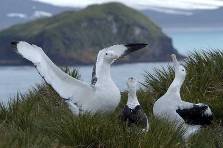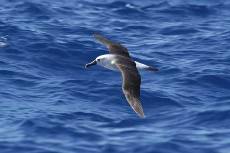ALBATROSSES FACE EXTINCTION
|

 Albatrosses are the most magnificent and impressive of all seabirds.
They are also some of the most endangered.
19 of the world's 22 species of albatross are seriously threatened by longline fishing with an estimated 100,000 drowned on longline hooks each year.
About 200,000 other seabirds, hundreds of thousands of sea turtles and over a million sharks are killed annually as bycatch on longlines.
Albatrosses are the most magnificent and impressive of all seabirds.
They are also some of the most endangered.
19 of the world's 22 species of albatross are seriously threatened by longline fishing with an estimated 100,000 drowned on longline hooks each year.
About 200,000 other seabirds, hundreds of thousands of sea turtles and over a million sharks are killed annually as bycatch on longlines.
|
| |
|
Since the 1980s longline fishing has been increasing, partly due to a growing demand for high quality fish in upmarket restaurants and partly due to a global ban on the use of drift nets.
Swordfish, blue- & yellow-fin tuna and Patagonian toothfish (better known as Chilean seabass) are some of the target species of longline fisheries.
The longlines consist of one main line with many smaller lines attached to it, each ending in a baited hook.
Lines can be over 100km in length and carry thousands of hooks.
Worldwide about 1 BILLION hooks are set every year.
|
| |
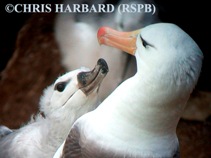 Albatross populations are particularly vulnerable to even small increases in adult mortality.
They live for up to 60 years, form pair-bonds for life and raise a single chick only once every 2 years.
Both parents are needed to raise the chick - if one is killed then the chick will almost certainly perish as well.
Recent tracking studies show that coastal and shelf areas are important feeding grounds for albatrosses, as are the rich regions where upwelling of cold ocean currents occur.
The waters frequented by albatrosses overlap significantly with those favoured by longline fisheries.
Like many other species of seabird, albatrosses have learned to scavenge for food behind fishing vessels.
As the longline hooks are set, baited with squid or fish, the birds snatch what looks like a tasty morsel and are then drowned as they are dragged underwater by the hook.
The current levels of bycatch are considered unsustainable - such high numbers of adult albatrosses are dying on longlines that they can't breed fast enough to keep up.
Albatross populations are particularly vulnerable to even small increases in adult mortality.
They live for up to 60 years, form pair-bonds for life and raise a single chick only once every 2 years.
Both parents are needed to raise the chick - if one is killed then the chick will almost certainly perish as well.
Recent tracking studies show that coastal and shelf areas are important feeding grounds for albatrosses, as are the rich regions where upwelling of cold ocean currents occur.
The waters frequented by albatrosses overlap significantly with those favoured by longline fisheries.
Like many other species of seabird, albatrosses have learned to scavenge for food behind fishing vessels.
As the longline hooks are set, baited with squid or fish, the birds snatch what looks like a tasty morsel and are then drowned as they are dragged underwater by the hook.
The current levels of bycatch are considered unsustainable - such high numbers of adult albatrosses are dying on longlines that they can't breed fast enough to keep up.
|
| |
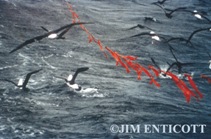 Fortunately, there are a number of simple, effective and relatively inexpensive ways to prevent seabirds from reaching the baited hooks.
Using streamer (tori) lines (shown in photo) to scare birds away while the longlines are being set has proved to be very successful.
Weighting the lines so that they sink faster, setting the lines at night when not many seabirds are feeding and not dumping offal (which attracts birds) while the lines are being set are all easy ways to reduce seabird mortality.
In well regulated fisheries such as those around the Falklands and South Georgia, these mitigation measures have been enforced for several years and as a result the number of seabird deaths is now almost zero.
Fortunately, there are a number of simple, effective and relatively inexpensive ways to prevent seabirds from reaching the baited hooks.
Using streamer (tori) lines (shown in photo) to scare birds away while the longlines are being set has proved to be very successful.
Weighting the lines so that they sink faster, setting the lines at night when not many seabirds are feeding and not dumping offal (which attracts birds) while the lines are being set are all easy ways to reduce seabird mortality.
In well regulated fisheries such as those around the Falklands and South Georgia, these mitigation measures have been enforced for several years and as a result the number of seabird deaths is now almost zero.
|
| |
 However, seabirds don't recognise man-made boundaries and many of the albatrosses nesting in large numbers on these islands travel far across the ocean to distant feeding grounds, for example off Brazil.
Some birds even circumnavigate the Southern Ocean before returning to land to breed.
Off the coasts of South America and southern Africa large fleets of longline boats operate and large numbers of seabird are being killed.
Educating these fishermen about how they can avoid catching birds and why it is important, providing them with tori lines and demonstrating their use on board the vessels and training observers to monitor bycatch are all vital tasks in the race to save albatrosses from extinction.
However, seabirds don't recognise man-made boundaries and many of the albatrosses nesting in large numbers on these islands travel far across the ocean to distant feeding grounds, for example off Brazil.
Some birds even circumnavigate the Southern Ocean before returning to land to breed.
Off the coasts of South America and southern Africa large fleets of longline boats operate and large numbers of seabird are being killed.
Educating these fishermen about how they can avoid catching birds and why it is important, providing them with tori lines and demonstrating their use on board the vessels and training observers to monitor bycatch are all vital tasks in the race to save albatrosses from extinction.
|
| |
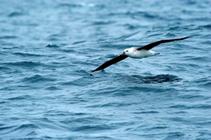 An international campaign by Birdlife International and the RSPB to 'save the albatross' before it is too late is currently underway.
One of the most important goals of the campaign is to set up Albatross Task Forces in key locations around the world to educate local fishermen.
So far there are teams in South Africa, Brazil and Chile and they are making a huge difference, saving the lives of seabirds.
More task force teams are needed urgently - seabirds are dying right now and the problem must be addressed at once if albatrosses are to survive.
Visit the Save the Albatross website to learn more about the threats facing seabirds, what is being done to prevent further needless deaths and how you can help support the campaign.
An international campaign by Birdlife International and the RSPB to 'save the albatross' before it is too late is currently underway.
One of the most important goals of the campaign is to set up Albatross Task Forces in key locations around the world to educate local fishermen.
So far there are teams in South Africa, Brazil and Chile and they are making a huge difference, saving the lives of seabirds.
More task force teams are needed urgently - seabirds are dying right now and the problem must be addressed at once if albatrosses are to survive.
Visit the Save the Albatross website to learn more about the threats facing seabirds, what is being done to prevent further needless deaths and how you can help support the campaign.
|
| |



 Albatrosses are the most magnificent and impressive of all seabirds.
They are also some of the most endangered.
19 of the world's 22 species of albatross are seriously threatened by longline fishing with an estimated 100,000 drowned on longline hooks each year.
About 200,000 other seabirds, hundreds of thousands of sea turtles and over a million sharks are killed annually as bycatch on longlines.
Albatrosses are the most magnificent and impressive of all seabirds.
They are also some of the most endangered.
19 of the world's 22 species of albatross are seriously threatened by longline fishing with an estimated 100,000 drowned on longline hooks each year.
About 200,000 other seabirds, hundreds of thousands of sea turtles and over a million sharks are killed annually as bycatch on longlines.
 Albatross populations are particularly vulnerable to even small increases in adult mortality.
They live for up to 60 years, form pair-bonds for life and raise a single chick only once every 2 years.
Both parents are needed to raise the chick - if one is killed then the chick will almost certainly perish as well.
Recent tracking studies show that coastal and shelf areas are important feeding grounds for albatrosses, as are the rich regions where upwelling of cold ocean currents occur.
The waters frequented by albatrosses overlap significantly with those favoured by longline fisheries.
Like many other species of seabird, albatrosses have learned to scavenge for food behind fishing vessels.
As the longline hooks are set, baited with squid or fish, the birds snatch what looks like a tasty morsel and are then drowned as they are dragged underwater by the hook.
The current levels of bycatch are considered unsustainable - such high numbers of adult albatrosses are dying on longlines that they can't breed fast enough to keep up.
Albatross populations are particularly vulnerable to even small increases in adult mortality.
They live for up to 60 years, form pair-bonds for life and raise a single chick only once every 2 years.
Both parents are needed to raise the chick - if one is killed then the chick will almost certainly perish as well.
Recent tracking studies show that coastal and shelf areas are important feeding grounds for albatrosses, as are the rich regions where upwelling of cold ocean currents occur.
The waters frequented by albatrosses overlap significantly with those favoured by longline fisheries.
Like many other species of seabird, albatrosses have learned to scavenge for food behind fishing vessels.
As the longline hooks are set, baited with squid or fish, the birds snatch what looks like a tasty morsel and are then drowned as they are dragged underwater by the hook.
The current levels of bycatch are considered unsustainable - such high numbers of adult albatrosses are dying on longlines that they can't breed fast enough to keep up.
 Fortunately, there are a number of simple, effective and relatively inexpensive ways to prevent seabirds from reaching the baited hooks.
Using streamer (tori) lines (shown in photo) to scare birds away while the longlines are being set has proved to be very successful.
Weighting the lines so that they sink faster, setting the lines at night when not many seabirds are feeding and not dumping offal (which attracts birds) while the lines are being set are all easy ways to reduce seabird mortality.
In well regulated fisheries such as those around the Falklands and South Georgia, these mitigation measures have been enforced for several years and as a result the number of seabird deaths is now almost zero.
Fortunately, there are a number of simple, effective and relatively inexpensive ways to prevent seabirds from reaching the baited hooks.
Using streamer (tori) lines (shown in photo) to scare birds away while the longlines are being set has proved to be very successful.
Weighting the lines so that they sink faster, setting the lines at night when not many seabirds are feeding and not dumping offal (which attracts birds) while the lines are being set are all easy ways to reduce seabird mortality.
In well regulated fisheries such as those around the Falklands and South Georgia, these mitigation measures have been enforced for several years and as a result the number of seabird deaths is now almost zero.
 However, seabirds don't recognise man-made boundaries and many of the albatrosses nesting in large numbers on these islands travel far across the ocean to distant feeding grounds, for example off Brazil.
Some birds even circumnavigate the Southern Ocean before returning to land to breed.
Off the coasts of South America and southern Africa large fleets of longline boats operate and large numbers of seabird are being killed.
Educating these fishermen about how they can avoid catching birds and why it is important, providing them with tori lines and demonstrating their use on board the vessels and training observers to monitor bycatch are all vital tasks in the race to save albatrosses from extinction.
However, seabirds don't recognise man-made boundaries and many of the albatrosses nesting in large numbers on these islands travel far across the ocean to distant feeding grounds, for example off Brazil.
Some birds even circumnavigate the Southern Ocean before returning to land to breed.
Off the coasts of South America and southern Africa large fleets of longline boats operate and large numbers of seabird are being killed.
Educating these fishermen about how they can avoid catching birds and why it is important, providing them with tori lines and demonstrating their use on board the vessels and training observers to monitor bycatch are all vital tasks in the race to save albatrosses from extinction.
 An international campaign by Birdlife International and the RSPB to 'save the albatross' before it is too late is currently underway.
One of the most important goals of the campaign is to set up Albatross Task Forces in key locations around the world to educate local fishermen.
So far there are teams in South Africa, Brazil and Chile and they are making a huge difference, saving the lives of seabirds.
More task force teams are needed urgently - seabirds are dying right now and the problem must be addressed at once if albatrosses are to survive.
Visit the Save the Albatross website to learn more about the threats facing seabirds, what is being done to prevent further needless deaths and how you can help support the campaign.
An international campaign by Birdlife International and the RSPB to 'save the albatross' before it is too late is currently underway.
One of the most important goals of the campaign is to set up Albatross Task Forces in key locations around the world to educate local fishermen.
So far there are teams in South Africa, Brazil and Chile and they are making a huge difference, saving the lives of seabirds.
More task force teams are needed urgently - seabirds are dying right now and the problem must be addressed at once if albatrosses are to survive.
Visit the Save the Albatross website to learn more about the threats facing seabirds, what is being done to prevent further needless deaths and how you can help support the campaign.

